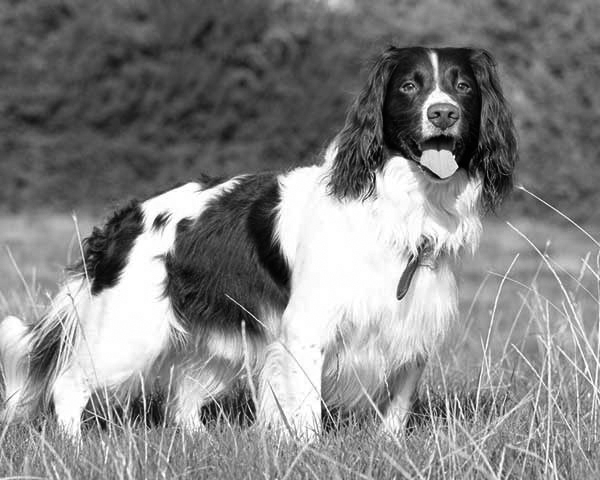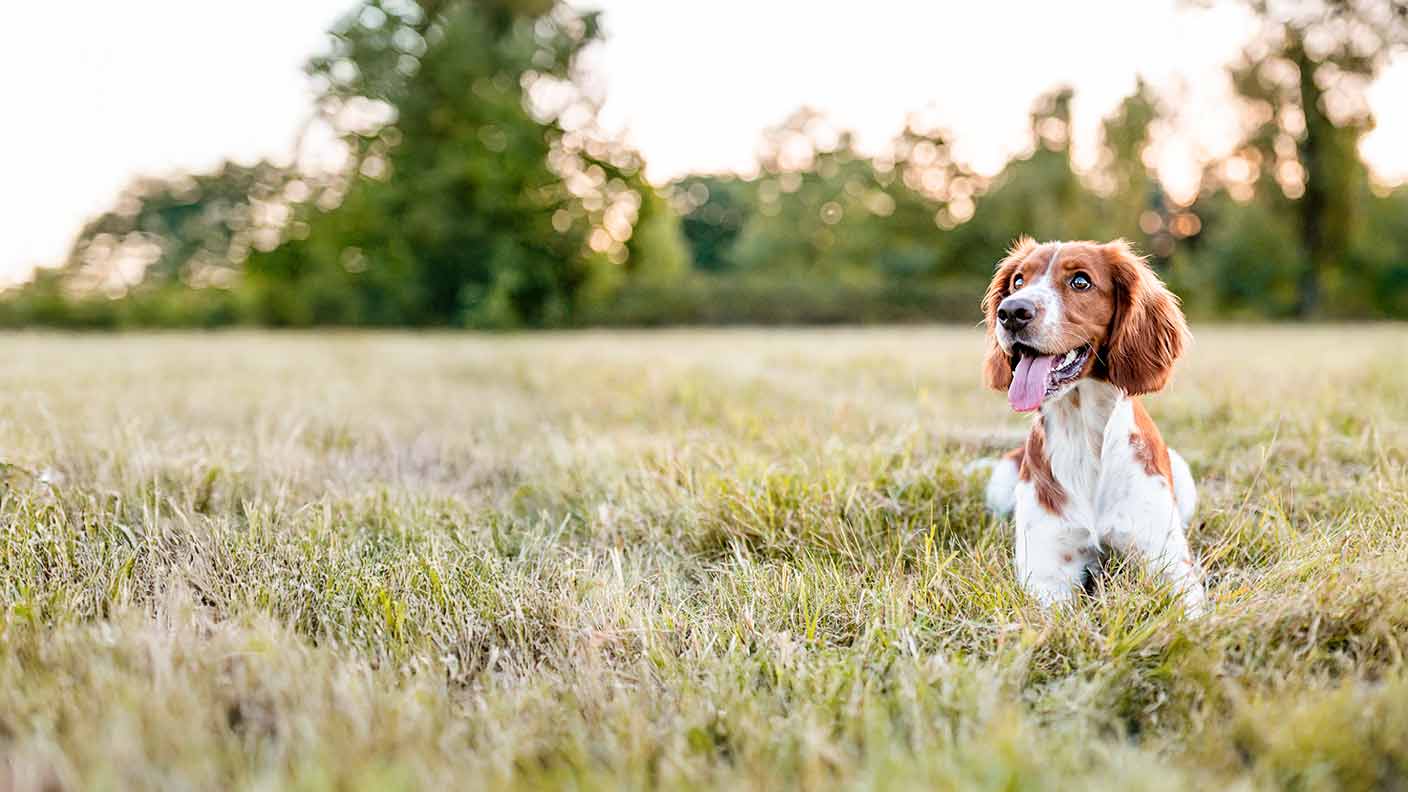Springer Spaniel dog breed information and advice
Loving, playful and full of energy, the Springer Spaniel is a popular gun dog. When you welcome one into your home, you welcome a dog that loves spending time with the family, is well-behaved, eager to learn and gets along with everyone.
If you’re looking to buy a Springer Spaniel, or English Springer Spaniel as they’re also known, this dog breed guide is perfect for you.
Discover everything you need to know from the Springer Spaniel temperament to their grooming, training and exercise needs. As well as some good go-to dog care tips and information about the Springer Spaniel lifespan.
Springer Spaniel facts

| Lifespan | 12 - 14 years |
| How much | £500 - £1500 |
| Size | 46 - 56 cm |
| Weight | 18 - 25 kg |
| Colours | liver & white, tricolour, orange & white, black & white, red & white, brown, golden, chocolate |
| Grooming | Every other day, depending on coat |
| Temperament | affectionate, intelligent, energetic |
| Exercise | Two hours a day |
Springer Spaniel insurance
Even with the greatest care, your dog may need veterinary treatment at some point in its life. Accidents and health problems can happen to any dog and treatment may bring expensive vet bills.
Springer Spaniels are at risk of developing the following health conditions:
• Hip dysplasia
• Elbow dysplasia
• Generalised progressive retinal atrophy (GPRA)
• Retina dysplasia
Dog insurance for your Springer Spaniel can help you with the cost of consultations, medication and surgery if needed. The cost of insurance depends on the policy you choose and the level of cover you require.
Sainsbury’s Bank Pet Insurance
Sainsbury's Bank Pet Insurance can protect your Springer Spaniel puppy from eight weeks old.
Our pet insurance also includes 24/7 Vet Assistance with every pet policy. So, you can rest easy knowing if you ever have any concerns about your pet, our trained vet nurses are on hand to answer any of your queries.
How to care for a Springer Spaniel dog
When caring for a Springer Spaniel dog, you’ll need to consider their diet, exercise, grooming and training needs.
Feeding and nutrition
Beware, Springer Spaniel dogs are greedy and can easily become overweight. If you have your Springer from a pup, they only have small tummies, so feed them little about three to four times a day. As adults, they should be fed twice a day.
To help keep their waistline in check, it’s good to weigh out their dog food, following guidelines on the packet. You can also speak to your vet for advice.
Grooming
When it comes to grooming, Springer Spaniel dogs can be demanding and need a once-over with a brush two to three times a week – depending on their coat. This will help to remove any fur that is shedding and prevent matting.
Don’t forget to brush and check their ears too. Because of their hairy ears Springer Spaniels are prone to ear infections, so you’ll need to regularly clean them carefully. A groomer or vet will be able to show you how to do this safely.
How often you need to bath your dog will depend on how dirty and smelly they are. In most cases, they only need bathing every six to eight weeks, but you’ll need to do it more often if your dog goes swimming – and they love water. You can bath them at home or take them to a groomer. They’ll also need a trim several times a year, so you could treat them to a doggy spa day every now and then.
Exercise
The Springer Spaniel temperament is playful, and they have an infectious energetic personality. This means they need around two hours of exercise a day. You could split these hours into multiple walks.
Playing with your dog is also a great way to exercise them. They were bred as a gun dog, so are great at retrieving balls. The best thing about playing fetch is that you can encourage your dog to get lots of exercise, without having to take much time out of your day.
Springer Spaniels are water dogs, if there is water nearby, your Springer Spaniel will be the first to get in it. Swimming is a great form of exercise that is gentle on their joints. The downside is that you’ll have to live with that wet dog smell, or bath them regularly.
Training
Springer Spaniel dogs were originally bred to flush out and retrieve game. This means they’re an athletic breed that needs lots of physical and mental stimulation. This means that training Springer Spaniels is quite easy and they’ll be keen to please their owners as they lap up human attention. Typically, they will respond best to a treat-based training regime.
As a pup, house or toilet training will hopefully be picked up quickly. Just take them to a designated area after every meal, give them a cue to go and give them the time to do their business. Once done, give them their praise and you’ll find they’ll soon get the hang of it.
If you pick up an adult rescue Springer Spaniel, it can be difficult to house train them. Just give them the time and a little bit more patience and they’ll pick it up eventually.
Temperament and behaviour
The Springer Spaniel’s temperament is what makes them a loving and obedient breed. They’re keen to please their owner and will be on their best behaviour if you give them lots of attention.
Common health problems
Certain health issues are common in Springer Spaniels. They’re an active breed that can easily be over-exercised. On the other hand, they can quickly gain too much weight. Both factors will affect their health. Pet insurance for your Springer Spaniel will help cover you in case anything happens to your pooch.
Take your dog for regular vet health checks to make sure they’re the correct weight and if they have any health problems that need additional care.
Hip dysplasia
This is an inherited joint disease, but the severity is influenced by weight and exercise. Hip dysplasia occurs when the ball-and-socket joint of the hip rubs together, causing damage to the surfaces of the joint. This is painful for the dog and eventually leads to arthritis.
An overweight or over-exercised dog is more likely to cause damage to the joint. Affected dogs will appear stiff or lame. Controlling your dog’s weight and restricting exercise will help relieve the symptoms. Severe conditions may need surgery to repair or replace the joint. Arthritic pain can be controlled with pain relief medication, giving the dog a reasonable quality of life.
Elbow dysplasia
Elbow dysplasia is similar in nature to hip dysplasia but affects the elbows instead. It is arthritis of the elbow joint and is a common cause of front leg lameness.
It’s caused by abnormal development, which means that the three bones that make up your dog’s elbow don’t fit together properly.
It’s considered to be a genetic disease, but it can also be affected by growth rate, poor nutrition, rapid weight gain and exercise level.
Generalised progressive retinal atrophy (GPRA)
GPRA is a group of inherited eye diseases. It’s a progressive condition that leads to blindness within months or years. This can’t be prevented as the condition is untreatable. However, most dogs learn to adapt to being blind and can live happy lives.
Affected dogs will start with poor vision at night and loss of peripheral vision. In some cases, cataracts may develop causing the eye to look cloudy. These signs are also common in other eye conditions, so you should speak to your vet if you notice any of them.
Retina dysplasia
Retina dysplasia refers to an abnormal growth of the retina that causes folds, rosettes or retinal detachment. It can affect one or both of their eyes. It’s usually inherited and affected dogs may have impaired vision or blindness. There’s no treatment available, but your vet will advise you on how you and your dog can live with the disease. A blind dog can still have a good quality of life.
So, is a Springer Spaniel dog right for you?
This affectionate breed is best suited for an active household. Their ideal day would involve going for a long walk, maybe a quick swim and then cuddling up on the sofa in the evening. If that sounds like your dream day, a Springer Spaniel will be your perfect companion.
How long do Springer Spaniel’s live?
The Springer Spaniel lifespan is 12 to 14 years. There are some health issues linked to this breed that may shorten their lifespan, but most conditions can be managed. With the right pet insurance, your dog can live a long and happy life.
Do Springer Spaniels shed?
The Springer Spaniel coat will shed all year, more so during Spring and Autumn. Grooming your dog weekly will help to remove some of the excess fur, but shedding can’t be prevented. Springers grow extra hair on the ears, chest and the rear of their legs. This fur will need to be brushed and trimmed regularly to stop it from matting.
How to train a Springer Spaniel
Springer Spaniels are popular as they’re obedient and easy to train. Springer Spaniel training is a great way to give them the mental and physical stimulation that they need. When training, positively reward your dog with a toy or treat to help them learn faster.
When do Springer Spaniels reach full size?
Most Springer Spaniels will be fully grown by 18 months, but their size can vary. You can expect them to reach 46 to 56 cm in height and 18 to 25 kg in weight. You will need to control their weight through diet and exercise as Springer Spaniels are greedy and can easily become overweight.
Frequently asked questions
Is a Springer Spaniel a good family dog?
The Springer Spaniel temperament is loving and energetic, so with the right set-up they can make brilliant family pets – just be sure that you can meet their high exercise requirements. They have a gentle nature and love going on adventures.
Do Springer Spaniels bark a lot?
Springer Spaniels are not seen to be excessive barkers, but they could develop bad habits if their exercise and socialisation needs aren’t satisfied. They’re a friendly breed and may bark to communicate with dogs and humans.
What issues do Springer Spaniels have?
Springer Spaniels can live long happy lives with the right owners and the correct environment to thrive. As a breed, there are some health conditions to be aware of. These include elbow and hip displasia, GPRA and retina dysplasia.

Browse our guides
Choose from our list of helpful guides and information

Explore dog breeds
Find out how to keep your dog healthy and happy

Cat breed guides
How to care for your cat, common health problems and more
References
Content provided from Vetstream's Vetlexicon Canis - www.vetstream.com/treat/canis 
Webster J & Llewellyn-Zaidi A (online) English Springer Spaniel. In: Vetlexicon Canis. Vetstream Ltd, UK. Website: https://vetstream.com/treat/canis/breeds-pages/english-springer-spaniel 
Harari J & Langley-Hobbs S (online) Hip: dysplasia. In: Vetlexicon Canis. Vetstream Ltd, UK. Website: https://vetstream.com/clinical-reference/canis/diseases/Hip-dysplasia 
Vetstream Ltd (online) Hip dysplasia Owner Factsheet. In: Vetlexicon Canis. Vetstream Ltd, UK. Website: https://vetstream.com/clinical-reference/canis/owner-factsheets/hip-dysplasia 
Brokos D E, Williams D L & Gould D (online) Retina: generalized progressive retinal atrophy. In: Vetlexicon Canis. Vetstream Ltd, UK. Website: https://vetstream.com/clinical-reference/canis/diseases/retina-generalized-progressive-retinal-atrophy 
Vetstream Ltd (online) Progressive retinal atrophy (PRA) Owner Factsheet. In: Vetlexicon Canis. Vetstream Ltd, UK. Website: https://vetstream.com/clinical-reference/canis/owner-factsheets/progessive-retinal-atrophy-(pra) 
Braund K, Cuddon P & Garosi L (online) Storage disease. In: Vetlexicon Canis. Vetstream Ltd, UK. Website: https://vetstream.com/clinical-reference/canis/diseases/storage-disease 
Vetstream Ltd (online) Storage disease in your dog Owner Factsheet. In: Vetlexicon Canis. Vetstream Ltd, UK. Website: https://vetstream.com/treat/canis/owner-factsheets/storage-diseases-in-your-dog-owner-factsheet 
Terms and conditions
Important information
Sainsbury's Bank plc, Registered Office, 33 Charterhouse Street, London, EC1M 6HA (registered in England and Wales, no 3279730) is authorised by the Prudential Regulation Authority and regulated by the Financial Conduct Authority and the Prudential Regulation Authority (register no. 184514).
Sainsbury's Supermarkets Ltd is an appointed representative of Sainsbury's Bank plc. Sainsbury's Bank plc acts as an introducer to Pinnacle Insurance Ltd who is authorised by the Prudential Regulation Authority and regulated by the Financial Conduct Authority and the Prudential Regulation Authority (register number 110866). Registered office: 4th Floor, Limelight, Elstree Way, Borehamwood, Hertfordshire, WD6 1JH. Sainsbury’s Bank Pet Insurance is arranged, administered and underwritten by Pinnacle Insurance Ltd. Sainsbury's Bank plc and Pinnacle Insurance Ltd are not part of the same corporate group.
We do not provide personal recommendations to customers.
